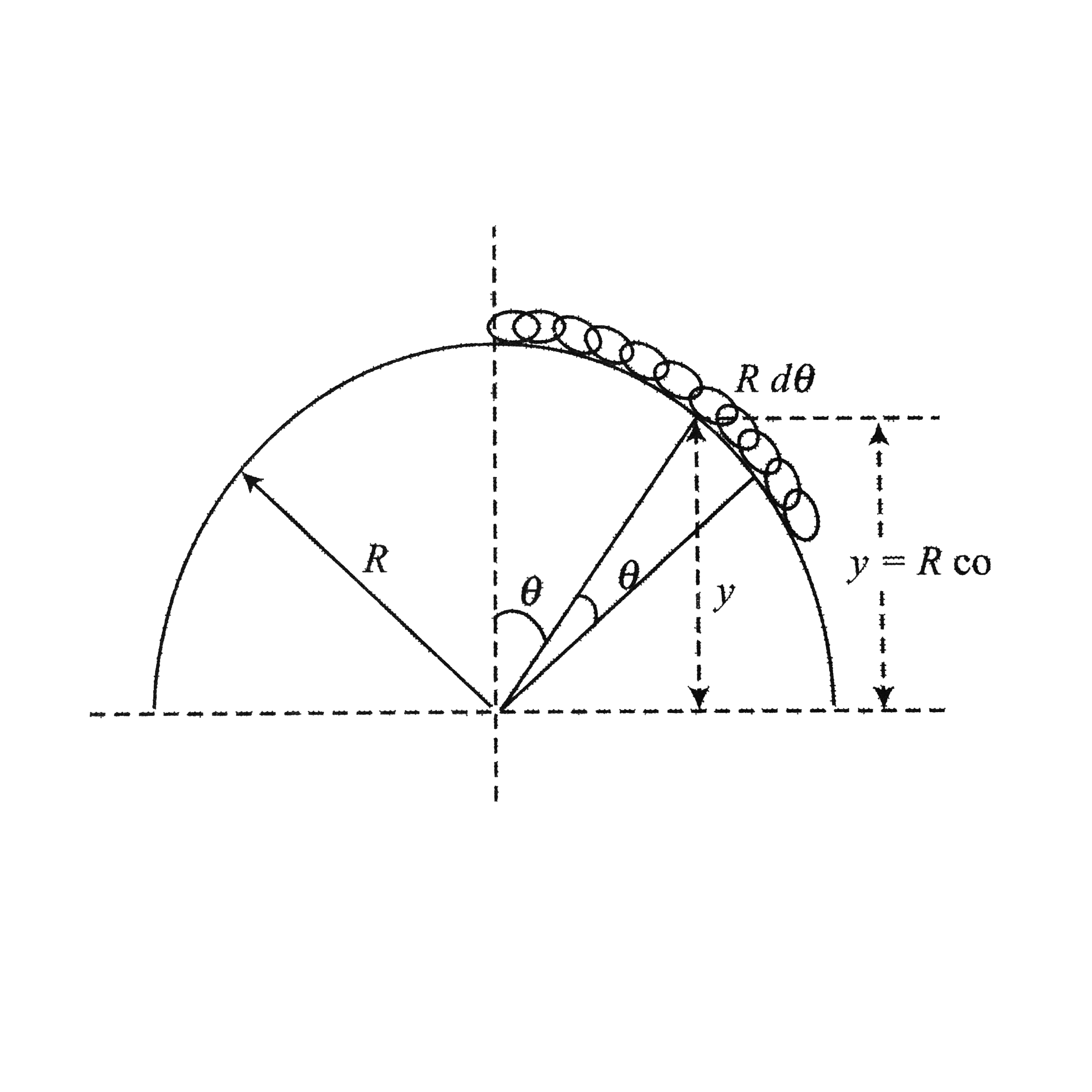AS chain of length l and mass m lies o the surface of a smooth sphere of radius R>l with one end tied to the top of the sphere. a.Find the gravitational potential energy of the chain with reference level at the centre of the sphere. B. suppose the chin is released and slides down the sphere. Find the kinetic eneergy of the chain, when it has slid through an angle θ c. find the tangential acceleration dvdt of the chain when the chain starts sliding down.
The correct Answer is:A, B
Let us consider a small element which makes angle dthη at the centre.
∴dm=ρ(mL)Rdthη
a. Gravitational potential energy of dm with respect to centre of the sphere
(dm)gRcosθ
=(mgL)R2cosθdthη<br><imga≤ocr_imageload∈g=lazysrc=https://d10lpgp6xz60nq.cloudfront.net/physics_images/HCV_VOL1_C08_E01_100_S01.pngwh=80%mx-autosty≤=background:white;><br>:. total G.P.E. =int_0^(L/R) mg R^2/L costheta dtheta<br>=(L/R)<br>=(mR^2g)/L[sintheta][theta=L/R]<br>=(mR^2g)/Lsin(L/R)<br>b.whenthecha∈isre≤asedomrestandslsdownthrughan∠θ,theK.E.ofthecha∈isgivenbyK.E.=chan≥ispotentiale≠rgy.<br>(mR^2g)/L sin (L/R)-int(gR^2)/L costheta dtheta<br>=(mR^2g)/L[sin(L/R)+sintehta-sin{theta+(L/R)}]<br>c.SinceK.E. =1/2 mv^2<br>=(mR^2g)/L[sin(L/R)]<br>tak∈gderivativeof⊥hsswithrespect→t,<br>(1/2)xx2xxx(dv)/(dt)<br>=(R^2g)/L[costheta-(dtheta)/dt)-cos(theta+L/R)(dtheta)/(dt)]<br>:. [R-(dtheta)/(dt) (dv)/dt<br>=(R^2g)/Lxx(dtheta)/(dt)[costhet-cos(theta+L/R)]<br>(becausev=Rω=Rdthηdt)
∴dvdt=RgL[cosθ−cos(θ+LR)]
When the chain strrts sliding down,
θ=0
∴dvdt=RgL[1−cos(LR)]
Topper's Solved these Questions
Similar Questions
A chain of length l and mass m lies of the surface of a smooth hemisphere of radius R>l with one end tied to the top of the hemisphere. Taking base of the hemisphere as reference line, find the gravitational potential energy of the chain.

View SolutionA uniform chain of mass m and length l<πR2 is placed on a smooth hemisphere of radius R with on of its ends fixed at the top of the sphere.
(a) Find the gravitational potential energy of chain assuming base of hemisphere as reference.
(b) what will be the tangential acceleraion of the chain when it starts sliding down.
(c ) If the chain slides down the sphere, find the kinetic energy of the chain when it has slipped through an angle β.
View Solution
Knowledge Check
A chain of length l=πR/4 is placed. On a smooth hemispherical surface of radius R with one of its ends fixed at the top of the sphere. Mass of chain is √πkg and R=1m.(g=10m/s2).
The gravitational potential energy of the chain considering reference level at the base of hemisphere isA20 JB20√2JC40 JD40√2JA chain of length l=πR/4 is placed. On a smooth hemispherical surface of radius R with one of its ends fixed at the top of the sphere. Mass of chain is √πkg and R=1m.(g=10m/s2).
If the chain sliped down the sphere, kinetic energy of the chain when it has sliped through an angle θ=π4.A23.4JB63.44JC80 JD97.4JTwo spheres each of mass M and radius R are separated by a distance of r. The gravitational potential at the midpoint of the line joining the centres of the spheres is
A−GMrB−2GmrC−GM2rD−4GMr
A chain of length l is placed on a smooth spherical surface of radius R with one of its ends fixed at the top of the sphere. What will be the acceleration w of each element of the chain when its upper end is released? It is assumed that the length of the chain l<12πR.
View SolutionA chain of length l is placed on a smooth spherical surface of radius R with one of its ends fixed at the top of the sphere. What will be the acceleration of the each element of the chain when its upper end is released? It is assumed that the length of the chain l<(πR2).
View SolutionA uniform chain of length 1 and mass m is kept on a smooth table. It is released from rest when the overhaning part was nth fraction of total length. Find the kinetic energy of the chain as it completely slips off the table

View SolutionA chain of length L and mass m is placed upon a smooth surface. The length of BA is (L−b). Calculate the velocity of the chain when its and reaches B

View SolutionThe gravitational field due to an uniform solid sphere of mass M and radius a at the centre of the sphere is
View Solution
